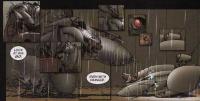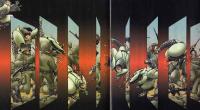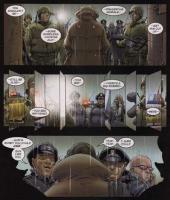I’ve been trying to write a post about Shaun of the Dead, but it’s been tough going. I know vaguely what I want to say, but I seem to have no interest in turning my vague thoughts into words. Oh well. Instead, I’ve been thinking about postmodern horror of an entirely different kind.
But should I first discuss what kind of postmodern horror Shaun of the Dead is, since I’ve already contrasted it with the kind of postmodern horror I actually want to write about? Yes, I suppose I should. Shaun of the Dead, of course, is in the tradition of self-conscious/ironic horror movies, movies like Scream and even Scary Movie. The authors (I will use “authors” to refer collectively to the people who made a movie) of Scream take on the relatively easy and ultimately banal task of making a straight slasher flick, with one crucial violation of the rules: the characters know about slasher flicks, spend much of their time discussing slasher flicks, and recognize immediately that they are living inside a slasher flick. The result is a movie that balances precariously on the line between jokiness and sincerity and isn’t quite deft enough to avoid stumbling. It’s reasonably entertaining, although the authors’ mocking indulgence in the slasher genre’s violent and exploitative virgin/whore morality makes for some particularly queasy scenes. The second and third movies might have improved on the formula—I don’t remember clearly.
Before I saw Shaun of the Dead, I expected a goofier, indier Scream. But whereas Scream approaches the problem of self-conscious postmodern narrative by presenting characters who discuss horror-movie cliches at the same time that they act out those cliches, the trailer for Shaun of the Dead suggests that it takes the different approach of riffing facetiously on little details and problems that tend to get glossed over in other movies—viz. the talk-show guest who insists on staying married to her zombified husband. Sort of a converse Scream, a self-conscious joke-horror movie that shakes up the familiar narrative by making the characters less clever instead of more—not only do they not notice the zombie-movie plot mechanics clunking along around them, they mess with the mechanics by failing to fall properly into their roles.
That’s what I thought before I saw the movie. Mostly, anyway—I’m partly reconstructing my thoughts in light of having seen it. What do I think now that I’ve finally seen it? Well, it’s sort of like I expected it to be, but it also has other more interesting things going on. It starts with a strong romantic-comedy foundation. Shaun is a 29-year-old guy who suspects he ought to take things more seriously but seems to have trouble finding things that right taking seriously. His sidekick is Ed, who “doesn’t have too many friends,” which is an understatement. Shaun’s girlfriend is Liz, who has tired of Shaun’s inertial inability to discover nightly entertainment opportunities outside the local pub. Her sidekicks are David and Dianne, a pretentious twat and a flightly failed actress, respectively. Liz is one botched date from dumping Shaun for good. David is in love with Liz and doing a pathetic job of hiding it from his girlfriend Dianne. Dianne wants to know when Shaun’s going to hook them up with free cable. Ed’s single endearing quality is his ability to perform a remarkably poor impression of an orangutan. Shaun—well, he doesn’t exactly want to spend the rest of his life drinking himself to death at the Winchester (the aforementioned local pub), but all the better alternatives have the flaw of requiring him to do something other than sit around the local pub.
Hmm, it’s been several days since I looked at this post. I seem to have been writing some kind of plot summary of Shaun of the Dead. But what’s the point—I don’t have the movie anymore, so I can hardly do a close reading. It’s been weeks since I saw the movie! I will now speak vaguely and noncomittally.
So Shaun of the Dead starts as a romantic comedy, and it could easily have kept going without zombies for a whole movie. Throwing in zombies is dangerous, because it means people like me might say, “If they wanted to do a romantic comedy about the unresolvable opposition of needing to grow up and not wanting to become one’s parents, why are they wasting their (and, more importantly, my) time with zombies?” But I didn’t say this while watching this movie. Partly because the authors take the time to play connect-the-themes. The shots of a stumbly, zombie-sounding Shaun who turns out to be merely a sleepy, yawning Shaun, the zombified wage-slave drones who are literally zombified and then put to work as—zombie slaves, I guess—funny jokes, but also plugged right into Shaun’s real-life concerns. (And, yes, terribly obvious and presumably done in every other zombie movie ever. Well, it’s a zombie movie, you work with what you’ve got. Shaun of the Dead works with what it’s got stylishly and intelligently. [???????But if they wanted to do a movie about the unresolvable opposition &c., why did they waste their time with zombies?” I’m not going to get into a defense of using the fantastic in art here, sorry. Um, because sometimes mere naturalism isn’t enough for some others, and then they break out the zombies.]) Let’s continue that line of thought, but outside the parentheses. What the zombie stuff does is latch onto specifc real-life concerns in the narrative, complicate and modify them, cause them to resonate with greater intensity.
Damn, I’ve been sloppy in talking about the romantic-comed aspect of Shaun of the Dead. Because, when you think about it, romantic comedy as a genre functions like a lot of fantasy—i.e., it latches onto specific real-life concerns, complicates and modifies them, causes them to resonate with greater intensity. So Shaun of the Dead has the romantic comedy and the zombies messing with the narrative. But is that enough for Edgar Wright and Simon Pegg? Certainly not. They add that extra layer of self-consciousness, which allows them to slip back and forth between zombies and romantic comedy without getting bogged down in either. There are three big things going on in the movie—the romantic comedy, the zombie stuff, and the mucky “human drama”—and each is so emotionally intense (and gorily harrowing, in the case of the zombie stuff) that it could easily overwhelm the whole movie. But the extra layer of irony allows the movie to flip deftly with precision timing from the chilling revelation of Shaun’s mum’s impending zombification to jokes about David wanting to shoot Shaun’s mum to simple “human drama” as the relationships between characters build tension and explode in heady conflict. The section of the movie from the musical zombie fighting/dancing choreographed to Queen’s “Don’t Stop Me Now” to the moment when Shaun, Liz and Ed find themselves trapped behind the bar is the final buildup and climax of the movie. These scenes have everything going on at once, and it really shouldn’t work but it does anyway, and it’s lovely.
Er, I guess I ended up writing a lot about Shaun of the Dead after all. And not about the kind of postmodern horror film I claimed I’d write about at the beginning of this post. I suppose I could edit the beginning of the post to make things make more sense, but I think I’ll leave it as is. More to come on postmodern horror… some time. I won’t promise timeliness.




